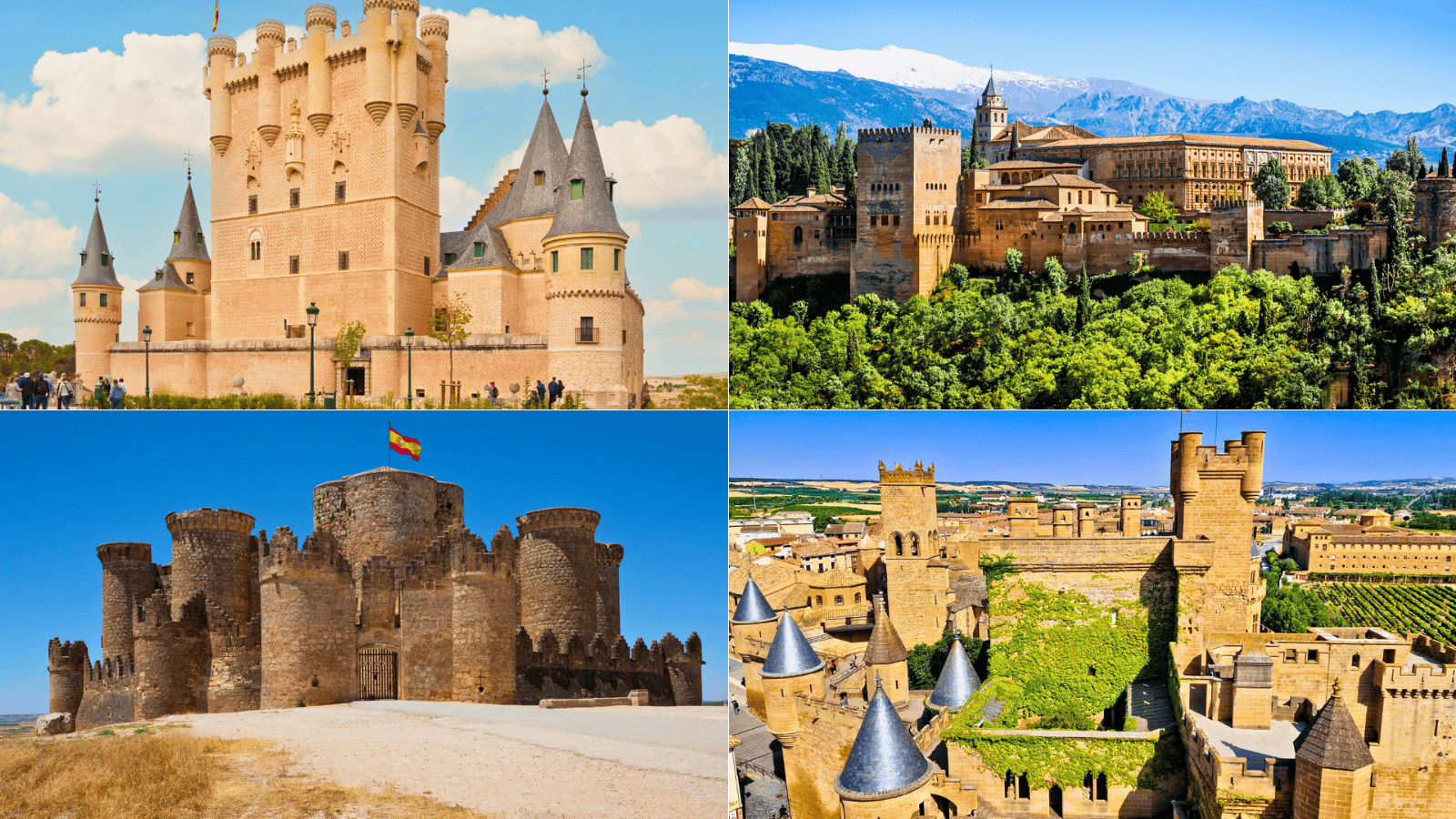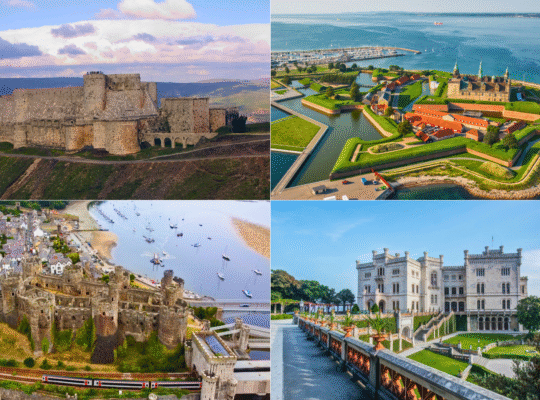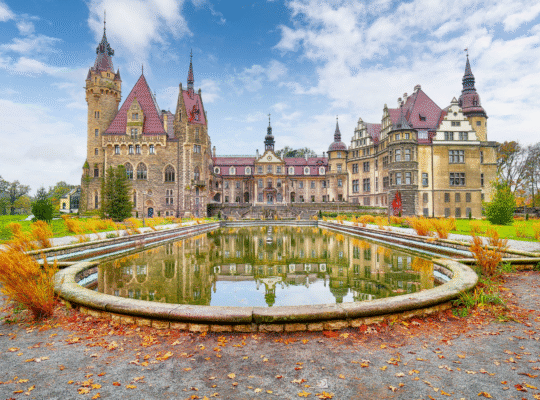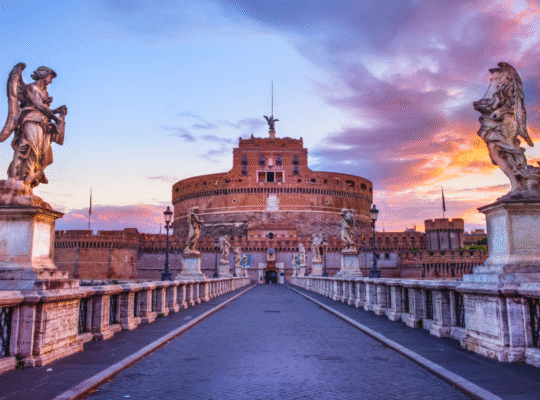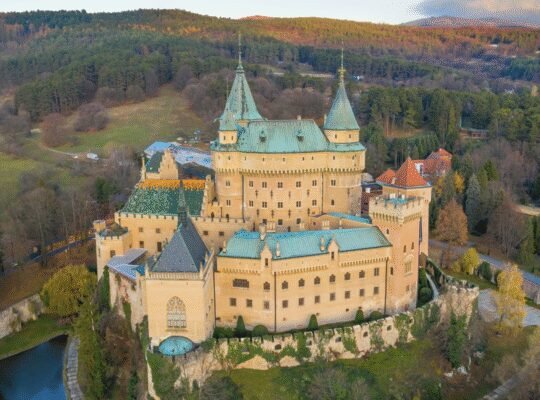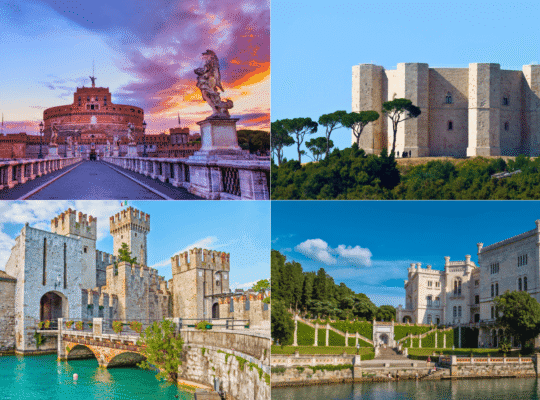If you’ve ever wondered whether castles in Spain live up to the stories—well, let me tell you, they don’t just live up to them. They knock them sideways.
My first real Spanish castle wasn’t planned. I was somewhere in Castilla y León, running late and nearly out of gas, when I crested a hill at sunrise. There it was: a fortress so dramatic it looked almost too perfect—turrets reaching for the sky, golden stone catching the first light, and a river snaking below. I actually stopped the car in the middle of the road, mouth open. Later, I found out it was the Alcázar of Segovia, a place that, legend has it, inspired Walt Disney’s Cinderella Castle. But that morning, it was just me, the cold air, and the sense that I’d stumbled into the opening scene of some ancient epic.
That’s the thing about castles in Spain. They’re not tucked away behind velvet ropes, collecting dust. They’re out in the wild—on lonely hilltops, deep in tangled old towns, or balanced on cliffs above rivers that look like they haven’t changed in centuries. Each one has its own heartbeat. Some are heavy with the ghosts of lost kingdoms; others burst with color, flowers, and laughter from local festivals. There are castles where queens were crowned, battles raged, and poets dreamed under star-filled skies.
You don’t have to be a history buff or even know the difference between a keep and a curtain wall. All you need is a dash of curiosity and a willingness to be surprised. Spain’s castles aren’t just about old stones and creaky gates—they’re about stories. Some are fierce and tangled; others quietly beautiful or outright bizarre.
In this guide, I’ll show you the ten best castles to visit in Spain. I’ll share what to look for, a few stories that stuck with me long after I left, and the kind of practical tips I wish someone had handed me before I tried to find parking in Granada on a festival day (spoiler: don’t). If you’re dreaming of adventure, craving a bit of old-world drama, or just want to stand somewhere that makes you feel small in the best possible way, these are the castles you need to see.
Let’s get started—because some secrets are too good to keep.

Quick Reference Table: The 10 Best Castles to Visit in Spain
| 🏰 Castle | 📍 Location | 🏗️ Era | 🎭 Famous For | 🎲 Fun Fact |
|---|---|---|---|---|
| Alcázar of Segovia | Segovia, Castilla y León | 12th–16th century | Fairytale silhouette, Disney inspiration | Built atop a rocky crag shaped like a ship |
| Alhambra | Granada, Andalusia | 13th–14th century | Moorish art, lush palaces & gardens | Last Moorish stronghold in Spain |
| Castle of Loarre | Huesca, Aragón | 11th century | Romanesque fortress, epic Pyrenees views | Filming location for “Kingdom of Heaven” |
| Castillo de Belmonte | Cuenca, Castilla-La Mancha | 15th century | Gothic towers, jousting tournaments | Privately owned—you can even stay overnight! |
| Castillo de Peñafiel | Valladolid, Castilla y León | 10th–15th century | Long, ship-like layout, wine museum | Looks like a stone ship from above |
| Castillo de Almodóvar del Río | Córdoba, Andalusia | 8th–14th century | Game of Thrones’ Highgarden | One of Spain’s best-restored castles |
| Castillo de Olite | Olite, Navarre | 13th–15th century | Maze of towers, royal palace vibes | Nicknamed “Versailles of Navarre” |
| Castillo de Manzanares el Real | Madrid Region | 15th century | Immaculate walls, close to Madrid | Hosts medieval reenactments and concerts |
| Castillo de Cardona | Cardona, Catalonia | 9th–15th century | Hilltop stronghold, parador hotel | The “Minyona Tower” has a tragic love legend |
| Castillo de la Mota | Valladolid, Castilla y León | 15th century | Red brick towers, massive moat | Was once a state prison for Queen Joanna |

Alcázar of Segovia
Quick Facts
| 🏗️ Construction Period | 12th–16th century |
| 🏰 Architectural Style | Medieval, Gothic, and Renaissance elements |
| 🎭 Famous For | Fairytale towers, Disney inspiration, royal palace |
| 👑 Notable Figures | Queen Isabella I, Alfonso VIII, Philip II |
| 🏆 UNESCO Status | Yes—Part of Old Town of Segovia and Aqueduct (Designated in 1985) |
| 🌐 Official Website | www.alcazardesegovia.com |
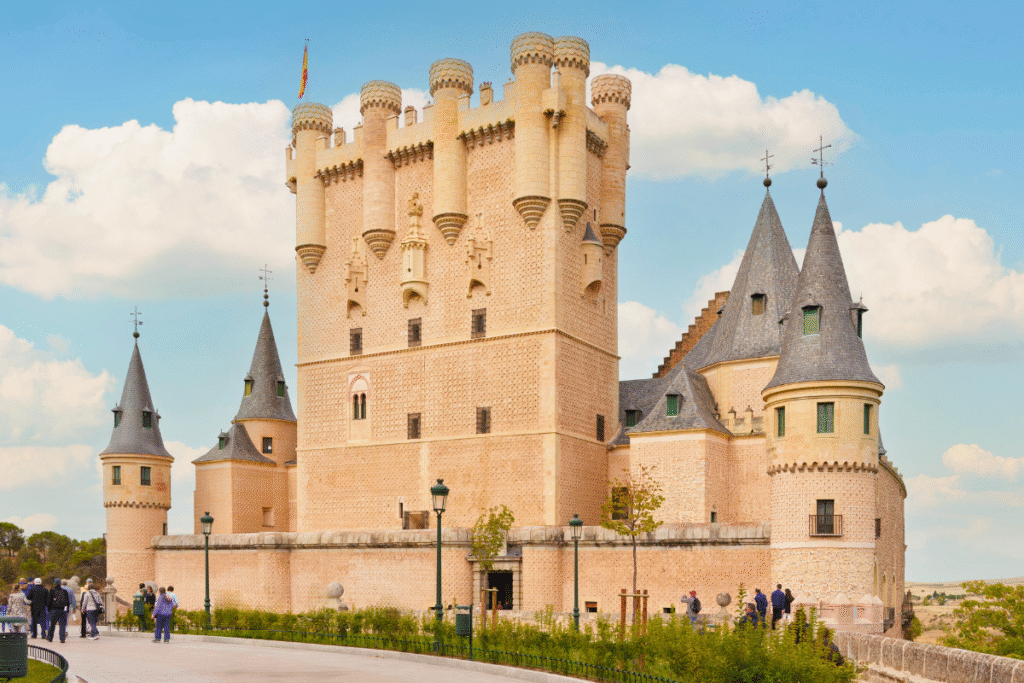
Walk through Segovia on a crisp morning, and the Alcázar practically calls out to you. It doesn’t just perch on a rocky cliff—it commands the whole skyline, its creamy stone walls jutting up above the treetops like something drawn for a fairytale. There’s no missing that ship’s prow silhouette, or the conical blue spires that look suspiciously familiar if you grew up with Disney movies. Yes, rumor has it this is the castle that inspired Cinderella’s.
But step a little closer, and you realize this isn’t just another pretty landmark. The Alcázar has worn many hats: royal palace, fortress, state prison, artillery college, and now, one of Spain’s most iconic monuments. Those thick walls have seen more drama than most soap operas—crowning ceremonies, betrayals, and a few wild legends that the guides here love to tell.
A Fortress Built for Legends
The earliest fortress probably stood here before the Romans, but the Alcázar we see today started to rise in the 12th century under King Alfonso VIII. Its position isn’t just for looks—this was a serious defensive stronghold, guarding the meeting of the Eresma and Clamores rivers below. Over time, Gothic and then Renaissance touches were added, especially under Isabella I, who was crowned Queen of Castile in the very Hall of the Throne.
Walk the halls and you’ll see evidence of royal ambition everywhere. Philip II—Spain’s famously somber king—remodeled the place, adding the slate-tipped turrets that give the Alcázar its unmistakable look. Later, it became a military academy (you can still spot old cannons and armor inside).
Myths, Murals, and More
It wouldn’t be a proper Spanish castle without a few stories. Some say secret tunnels once ran from the Alcázar into Segovia’s heart—perfect for a dramatic escape. Others whisper about Isabella’s coronation, when her enemies plotted to stop her right up to the last second. There’s even talk of ghosts, though the only chills I ever got came from climbing the dizzying Tower of John II, which offers what might be the best view in all of Castile.
Look out for the ornate ceilings, painted with golden pineapples and flowers, and the Throne Room, where velvet banners and tapestries still hang. It feels more like a film set than real life—except it’s very, very real.
Why This Castle Makes the Top 10
You could visit Segovia just for the castle and leave happy, but the Alcázar offers more than just a photogenic backdrop. It’s the way it fuses fairytale romance with raw history. The stories linger in the shadows, and that climb to the top—steep and narrow—rewards you with a jaw-dropping panorama of the old town and the Roman aqueduct stretching off into the horizon.
Plus, as part of a UNESCO World Heritage Site, the Alcázar isn’t just famous in Spain. It’s recognized around the world for its cultural and historic value.
Spain Castle Travel Tips: Visiting the Alcázar
- Getting There: Easy day trip from Madrid by AVE train or bus; the walk from Segovia’s old town is uphill but worth it.
- Entry: General admission €7–€10 (tower entry extra). Visit the official website for current prices and opening hours.
- Tours: Audio guides in several languages; guided tours often available.
- Accessibility: Most main rooms accessible, but the tower climb is steep and narrow.
- Best Time to Visit: Spring and early autumn for fewer crowds and pleasant weather. Early morning or late afternoon for the quietest experience and the best light on the castle.
- Must-Know: Arrive early or later in the afternoon—midday crowds can be thick, especially on weekends.
Nearby Attractions & Must-Dos
- Segovia’s Roman Aqueduct: Just a short stroll away, this ancient marvel will blow your mind.
- Cathedral of Segovia: Stunning late Gothic architecture, right in the main square.
- Cochinillo (Roast Suckling Pig): The local dish—don’t leave town without trying it at a classic mesón.
Honestly, if you’re hunting for a castle that feels both magical and fiercely real, Alcázar of Segovia is your place. And if you’re anything like me, you’ll be back the next morning—just for one more sunrise on those towers.

Alhambra
Quick Facts
| 🏗️ Construction Period | 13th–14th century (Nasrid dynasty) |
| 🏰 Architectural Style | Moorish/Islamic, Nasrid Palaces |
| 🎭 Famous For | Intricate tilework, lush Generalife gardens, palaces, fortress walls |
| 👑 Notable Figures | Yusuf I, Muhammad V, Ferdinand & Isabella |
| 🏆 UNESCO Status | Yes—Alhambra, Generalife, and Albayzín (since 1984) |
| 🌐 Official Website | www.alhambra-patronato.es |
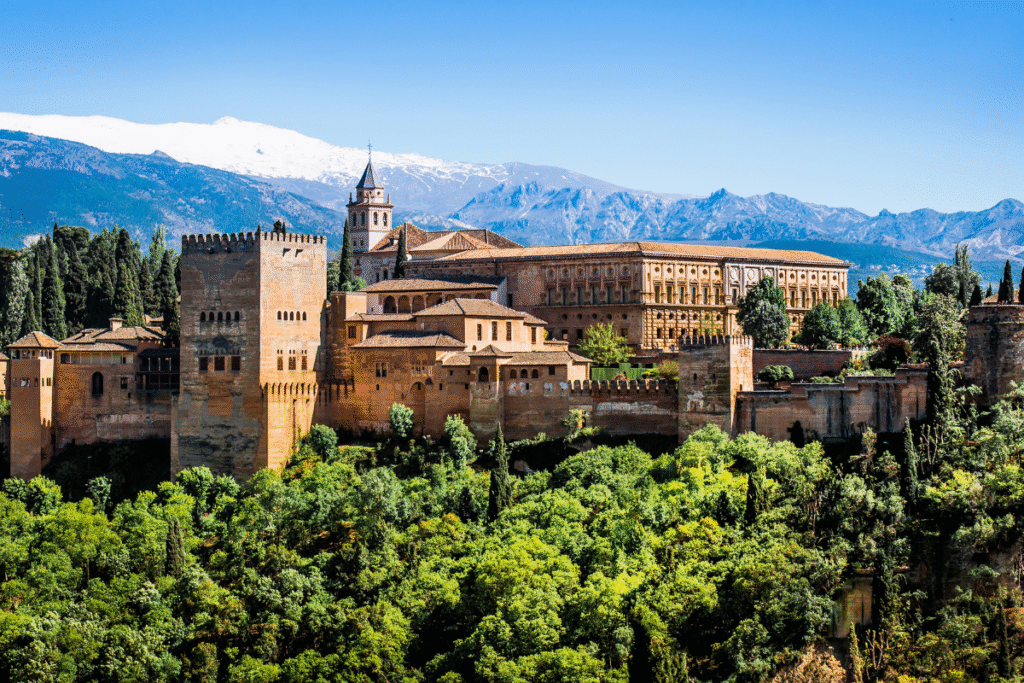
If there’s one Spanish castle that feels plucked straight from a dream, it’s the Alhambra. The first time I saw its red walls glowing in the evening sun, I remember thinking it looked almost too delicate for this world—like it might float away on a cloud of jasmine and guitar music. But the closer you get, the more you realize: this place is built to last. And it’s packed with stories.
Palaces, Poems, and a Last Stand
The Alhambra rises above Granada on Sabika Hill—a royal city within a city. It started in the mid-1200s, built by the Nasrid dynasty as both fortress and palace. At its height, it was the last Muslim stronghold in Spain, a glittering court where poets, sultans, and scholars walked echoing halls lined with Arabic script. Legend has it that the walls still “whisper” their poetry if you listen closely.
It’s a place where history pivots. In 1492, Ferdinand and Isabella took Granada, ending centuries of Islamic rule. The last Nasrid ruler, Boabdil, is said to have wept as he looked back one final time—a spot still called the “Moor’s Sigh.” The Catholic monarchs claimed the Alhambra, and over the centuries, Christian and Renaissance details crept in, but the Moorish soul remains.
Courtyards, Carvings, and Secret Corners
Visiting the Alhambra is like wandering through an endless maze of beauty. You’ll find endless courtyards, each with its own fountain or reflecting pool. The Nasrid Palaces are the highlight: lace-like plasterwork, carved wooden ceilings, and those famous tiles—each a geometric riddle. The Patio of the Lions is probably the most photographed, and for good reason: marble lions circle a central fountain, their fierce faces softened by centuries of water.
Don’t skip the Generalife gardens, where cypress hedges, roses, and bubbling streams make you feel like you’ve stumbled into paradise. And then there’s the Alcazaba fortress, where you can climb the ramparts for sweeping views over the city and the snow-capped Sierra Nevada beyond.
Why This Castle Makes the Top 10
The Alhambra isn’t just a castle—it’s a complete world. It blends art, architecture, and nature in a way that feels alive, even centuries later. For anyone curious about Spain’s tangled history or just hungry for jaw-dropping beauty, this is the crown jewel.
Its UNESCO World Heritage status says it all, but even that feels too small a label for a place that has inspired artists, writers, and daydreamers from Washington Irving to M.C. Escher.
Spain Castle Travel Tips: Visiting the Alhambra
- Getting There: Walk or taxi from Granada’s old town, or take the C30/C32 minibus (expect a bit of a climb).
- Entry: Tickets from €18; must be reserved in advance, often weeks ahead in high season. See the official site for up-to-date prices and times.
- Tours: Strongly recommended—there’s so much to miss otherwise. Official guided tours and audio guides are available.
- Accessibility: Most main areas accessible, but there are uneven paths and steps.
- Best Time to Visit: Late spring and early autumn—fewer crowds, gardens at their best. Early morning or evening slots offer softer light and a quieter mood.
- Must-Know: Arrive 30 minutes before your scheduled time (your ticket has a timed entry for the Nasrid Palaces). Bring water, as shade is limited.
Nearby Attractions & Must-Dos
- Albayzín: The old Moorish quarter, with winding streets and stunning views of the Alhambra.
- Mirador de San Nicolás: Best sunset lookout in Granada—bring your camera.
- Local tapas bars: Granada’s tradition is free tapas with every drink. Try local favorites like berenjenas con miel (fried eggplant with honey).
If you’re planning to visit or just want to dive deeper into this palace’s secrets, don’t miss our complete Alhambra in Granada, Spain guide packed with legends, practical tips, and stunning photos.
There are many castles in Spain, but there’s only one Alhambra—a place where every wall and whisper carries a piece of Spain’s soul. If you go, take your time. Some places are worth getting lost in.

Castle of Loarre
Quick Facts
| 🏗️ Construction Period | 11th century (expanded 12th century) |
| 🏰 Architectural Style | Romanesque military fortress |
| 🎭 Famous For | Towering position over Pyrenees, ancient chapel, filming location |
| 👑 Notable Figures | King Sancho III of Navarre, King Sancho Ramírez |
| 🏆 UNESCO Status | Not UNESCO, but listed as a Spanish National Monument |
| 🌐 Official Website | https://castillo-loarre.es |
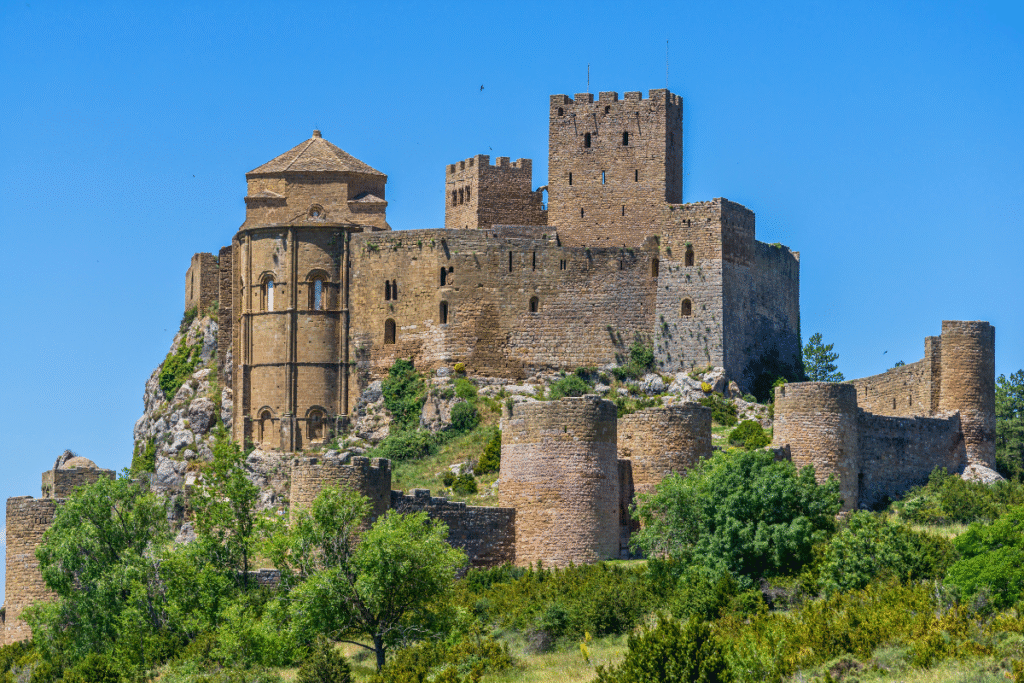
There are castles that stand guard over towns, and then there’s Loarre—a stone sentinel anchored high on a rocky hill, with the Pyrenees rolling off behind it like some wild green sea. If you ever want to feel like you’ve stumbled into a medieval epic (or a Ridley Scott movie), this is the place. And in fact, if the walls look familiar, that’s because “Kingdom of Heaven” filmed some of its sweeping battles right here.
Spain’s Oldest Fortress—Alive With Echoes
Castle of Loarre isn’t just old—it’s legendary. Built in the early 11th century as a front-line defense against Moorish forces, it’s the oldest Romanesque castle in Spain still standing more or less as it was. You can almost picture chainmailed soldiers watching the valleys below, or monks walking to the castle chapel, which is still beautifully intact. The silence here is deep; stand in the old towers and you’ll swear you can hear the wind carrying stories from a thousand years ago.
For centuries, Loarre was the key to the Kingdom of Aragón, holding off invaders and watching over the fertile plains. Its thick walls, round towers, and arched gates are built for defense, but it’s the air of mystery that gets you. According to local legend, secret tunnels connect the fortress to hidden caves beneath the hill—escape routes for desperate defenders.
What Makes Loarre a Medieval Marvel
Walk through the main gate and you’re instantly transported. The castle’s layout is tight and purposeful—tower after tower, with high curtain walls, watch posts, and a keep that dominates the site. The church of San Pedro, with its elegant apse and crypt, is a highlight: sunlight streams through narrow windows, and the stone still smells faintly cool, even on a hot day.
If you climb to the top, you get a view that will stop you in your tracks: patchwork fields, distant peaks, and clouds sweeping over the valley. There’s little here in the way of luxury—this is a place of stark beauty, not royal frills. But if you want a castle that feels untouched by time, Loarre is it.
Why This Castle Makes the Top 10
Loarre is here because it’s pure, raw, and unforgettable. No velvet ropes, no endless gift shops—just stone, sky, and a history that stretches back almost a thousand years. It’s a favorite with photographers and film crews for good reason: the drama is all in the landscape, the ruins, and the epic scale of it all.
For anyone fascinated by medieval Spain, this is one of the last places where you can truly feel that ancient energy.
Spain Castle Travel Tips: Visiting Loarre
- Getting There: You’ll need a car—about 30 minutes from Huesca, or 1.5 hours from Zaragoza. The drive is worth it for the views alone.
- Entry: Tickets usually around €7–€9. Guided tours available (highly recommended for the full story). Check the official website for current prices and seasonal hours.
- Tours: Tours run daily, and there are information panels in English and Spanish if you prefer to wander.
- Accessibility: The climb up to the castle is steep and uneven, and inside you’ll find stairs and rugged paths—wear sturdy shoes.
- Best Time to Visit: Spring and autumn for cooler temperatures and clear views. Arrive early to catch the morning light on the walls and beat the tour buses.
- Must-Know: Bring water, sun protection, and a camera with lots of space.
Nearby Attractions & Must-Dos
- Mallos de Riglos: Iconic red rock formations just a short drive away—popular for hiking and rock climbing.
- Huesca Old Town: Charming squares, a Gothic cathedral, and excellent local tapas.
- Birdwatching: The region is famous for raptors; look up and you might spot griffon vultures circling overhead.
I’ll be honest: the first time I visited Loarre, I stayed too long and ended up driving home by moonlight. But that’s the kind of place this is—you lose track of time, and for a little while, it’s just you, the wind, and the stones that remember everything.

Castillo de Belmonte
Quick Facts
| 🏗️ Construction Period | 1456–1470 |
| 🏰 Architectural Style | Gothic with Mudejar and Renaissance touches |
| 🎭 Famous For | Star-shaped design, medieval festivals, movie set |
| 👑 Notable Figures | Juan Pacheco, Eugenia de Montijo |
| 🏆 UNESCO Status | Not a UNESCO site, but declared a Spanish National Monument |
| 🌐 Official Website | www.castillodebelmonte.com |

Approaching Belmonte is a bit of a jaw-dropper. There it sits, all angles and ramparts, looming above endless plains like it’s daring someone—anyone—to try and take it. And thanks to its perfect star shape, from above it looks more like a spiky crown than your average medieval fortress. You half expect a dragon to be circling overhead.
A Fortress with Flair (and Stories to Spare)
Castillo de Belmonte is younger than most on this list, but it’s packed with personality. Built by Juan Pacheco, one of the most powerful men in 15th-century Castile, it was both a defensive powerhouse and a showpiece. Pacheco had ambition to spare—this was meant to signal his power to everyone for miles around.
Its thick walls once guarded nobles, knights, and the occasional rival. Over centuries, the castle saw wars, betrayals, and the slow creep of Renaissance elegance. In the 19th century, it became the property of Eugénie de Montijo—Empress of France and wife of Napoleon III. She poured in money to restore the place, saving it from ruin.
Legends, Tournaments, and a Taste for Drama
There’s no shortage of legends here. Some say the dungeons are haunted by unfortunate prisoners. Others claim that tunnels run from the castle out into the surrounding fields—just in case an escape was needed. What really sets Belmonte apart, though, is how alive it feels today.
Every year, medieval festivals bring knights in armor clashing in real jousts (yes, with horses and lances), and the castle has starred in everything from “El Cid” to “Game of Thrones”-era epics. You can even try archery or wield a (practice) sword yourself.
What Makes Belmonte Stand Out
It’s the blend of power and beauty. Walk the ramparts and you’ll get sweeping views over wheat fields and olive groves—on a clear day, you can see for miles. The main courtyard is pure Gothic drama, while inside you’ll find rooms filled with armor, weapons, and period furnishings. The castle has kept its star shape, massive keep, and most of its original towers—unlike many others, you really get the full medieval experience.
There’s a sense of fun, too. This isn’t a dusty relic; it’s a living, breathing castle with activities for all ages. You can even book a night inside—sleep under ancient beams and wake up to sunrise over the ramparts.
Spain Castle Travel Tips: Visiting Belmonte
- Getting There: Best reached by car; about 1.5 hours from Madrid or Valencia. Free parking right below the hill.
- Entry: General admission around €10; discounts for kids and groups. Special event days (jousting, festivals) may have different rates. See official site for details.
- Tours: Free audio guides included with entry; guided group tours in Spanish and sometimes English.
- Accessibility: Main paths and lower levels are accessible; towers and ramparts have stairs.
- Best Time to Visit: Spring and autumn for cooler weather. Time your visit to coincide with a festival for the full experience.
- Must-Know: Festival days get crowded—book tickets in advance.
Nearby Attractions & Must-Dos
- Belmonte Village: Quiet squares, old churches, and classic La Mancha cuisine (try the duelos y quebrantos).
- Windmills of Mota del Cuervo: Just a short drive—think “Don Quixote” country.
- Uclés Monastery: An impressive religious complex known as “El Escorial de la Mancha.”
If you’re the type who likes your history hands-on and a little dramatic, Belmonte should be on your Spain castle itinerary. My advice? Bring a sense of adventure—and maybe a camera, in case you feel the urge to storm a rampart or two.

Castillo de Peñafiel
Quick Facts
| 🏗️ Construction Period | 10th–15th century |
| 🏰 Architectural Style | Medieval fortress, elongated ship-like plan |
| 🎭 Famous For | Unique layout, towering above Ribera del Duero, wine museum |
| 👑 Notable Figures | Juan Manuel, Infante of Castile; King Alfonso X |
| 🏆 UNESCO Status | Not UNESCO, but recognized as a Spanish Cultural Heritage Site |
| 🌐 Official Website | https://www.turismocastillayleon.com/en/heritage-culture/castle-penafiel |
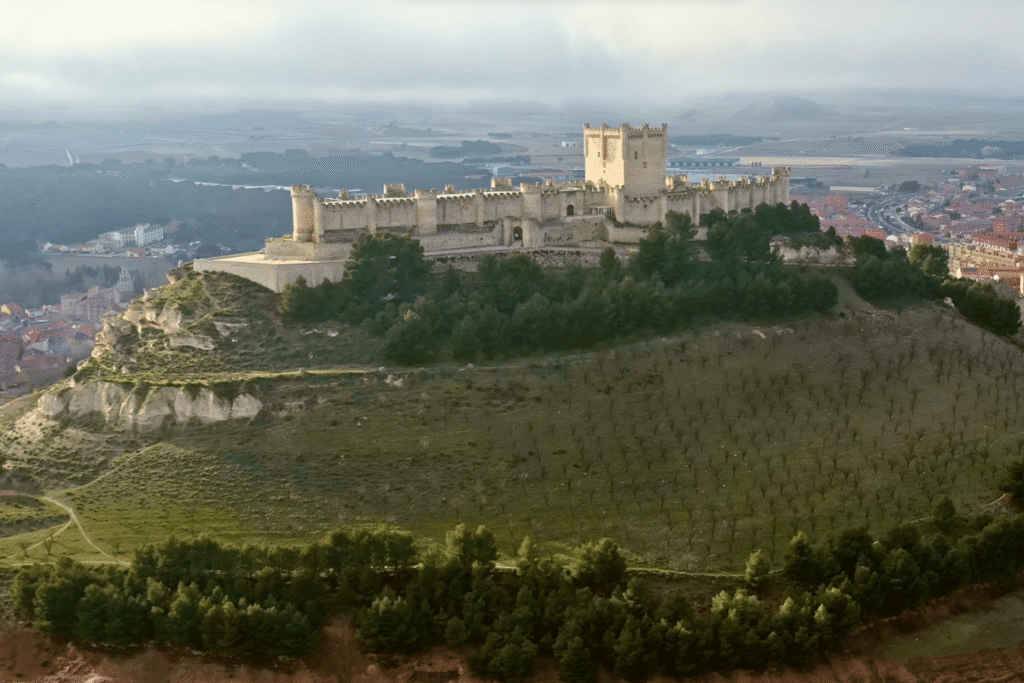
Some castles sprawl; Peñafiel soars. Stretched across a narrow limestone ridge, this fortress looks for all the world like a stone battleship slicing through the Castilian sky. From above, it’s long and lean—one of the most unique silhouettes in Spain. But it’s when you climb the hill and see it looming over the vineyards that you really appreciate the drama.
A Ship on the Hill—and a Guardian of Wine Country
Peñafiel has been standing guard over the Ribera del Duero since the 10th century, keeping watch over a landscape now famous for world-class wine. It started as a Moorish outpost before being taken and rebuilt by Christian forces. The castle we see today grew in importance through the Middle Ages, especially under Don Juan Manuel, a legendary writer and nobleman who shaped its final form.
For centuries, this was a stronghold no one wanted to tangle with. Thick walls, 30-meter-high keep, arrow slits, and towers—it’s a classic fortress, but that long, ship-like plan makes it one of a kind. And if you’re picturing sword fights and sieges, you’re not far off. Tales of intrigue, betrayal, and midnight escapes linger in every corridor.
Legends, Dungeons, and a Cellar Full of Surprises
The castle is full of stories. Some say its dungeons held high-ranking prisoners; others tell of a legendary tunnel used by desperate captives to escape. My favorite bit of local lore? That the castle itself was built to resemble a ship on purpose—its prow pointed toward the enemy, its towers like sails.
These days, the surprise isn’t just the architecture: inside the keep, you’ll find the Provincial Wine Museum. Yes, you read that right. You can learn about centuries of winemaking and taste some of the best Ribera del Duero has to offer—without leaving the ramparts.
Why This Castle Makes the Top 10
Peñafiel stands out for its shape, its setting, and its living connection to the region. For wine lovers, it’s an absolute must, but even if you don’t drink, the views from the tower are reason enough to make the climb. There’s something magical about watching the sun set over endless vineyards, the stone walls glowing gold, and the air carrying the scent of grape must.
It’s also less crowded than many castles, so you often get the run of the place—perfect for channeling your inner knight or just savoring the peace.
Spain Castle Travel Tips: Visiting Peñafiel
- Getting There: About 2 hours by car from Madrid or Burgos; easiest to drive, but buses serve the town from Valladolid.
- Entry: Admission around €6–€8, which includes a guided tour and wine museum visit. Check the official website for current prices and hours.
- Tours: Guided visits required for the keep; wine museum self-guided.
- Accessibility: The climb up the hill and stairs inside can be demanding; limited access for mobility needs.
- Best Time to Visit: Spring and fall, when the vineyards are at their most beautiful. Early or late in the day for cooler temperatures and better photos.
- Must-Know: Book your tour ahead, especially during wine harvest season—spaces fill up fast.
Nearby Attractions & Must-Dos
- Ribera del Duero wineries: Do a tasting tour—you’re in the heart of Spanish wine country.
- Plaza del Coso: Medieval bullring at the castle’s base, lined with wooden balconies.
- Valbuena de Duero Monastery: Just a short drive for a dose of local history and tranquility.
If you’re after a castle with a unique shape, a rich backstory, and a side of world-class wine, Peñafiel delivers. Don’t rush—let the view, the history, and maybe a glass of Tempranillo linger a while.

Castillo de Almodóvar del Río
Quick Facts
| 🏗️ Construction Period | 8th–14th century (originally Moorish, rebuilt later) |
| 🏰 Architectural Style | Moorish fortress with Gothic and Neo-Mudéjar elements |
| 🎭 Famous For | Game of Thrones filming location (Highgarden), panoramic hilltop views |
| 👑 Notable Figures | Abd ar-Rahman II, Alfonso XI, Christian and Moorish rulers |
| 🏆 UNESCO Status | Not UNESCO, but declared a Spanish Cultural Heritage Site |
| 🌐 Official Website | www.castillodealmodovar.com |
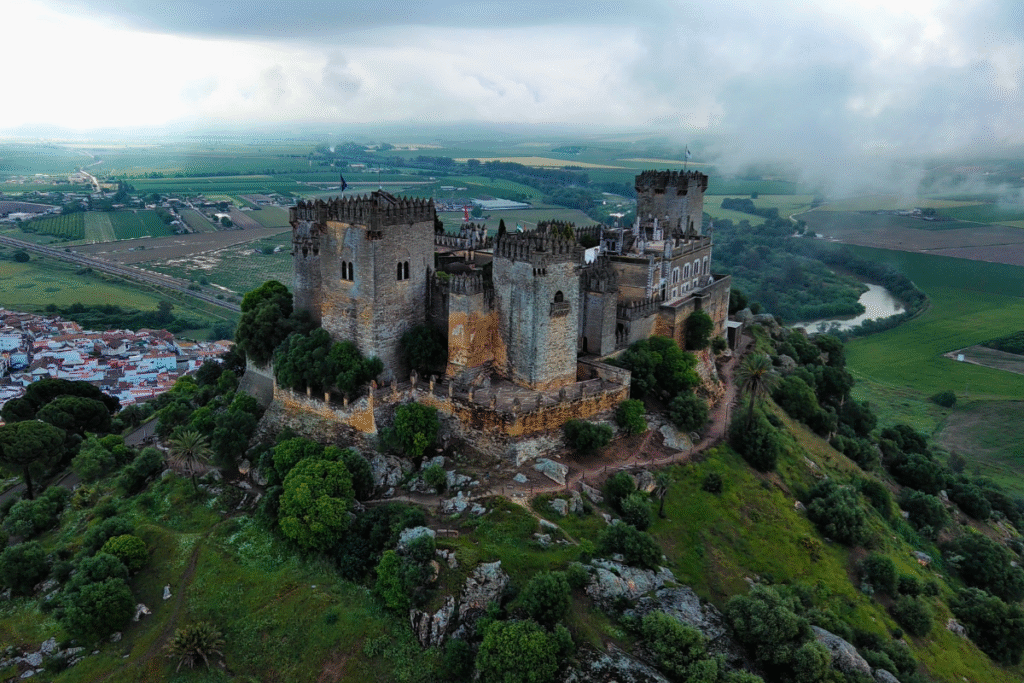
Drive the winding road up to Almodóvar del Río and, even before you see the walls, you’ll spot it rising like a crown above the olive groves. This castle is pure drama—a wild blend of Moorish roots and medieval swagger, with towers that seem to punch the sky and ramparts that snake along the hilltop. There’s a reason the “Game of Thrones” crew picked it to stand in for the gardens of Highgarden: it’s jaw-dropping from every angle.
Fortress of Conquest, Siege, and Survival
Almodóvar started life in the 8th century as an Arab fortress guarding the river below. Over the centuries, it changed hands countless times—Moorish and Christian rulers both left their mark, each adding their own layers. Alfonso XI used it as a royal residence, and during the Reconquista, it became a vital stronghold.
But unlike many Spanish castles, Almodóvar hasn’t faded into gentle ruin. In the early 1900s, its passionate owner, the Count of Torralva, poured years (and a fortune) into restoring the fortress, rebuilding towers, walls, and courtyards until it gleamed. Today, it’s one of the best-preserved castles in Spain—alive with stories, legends, and more than a little local pride.
Legends, Tunnels, and a Touch of Fantasy
The castle is woven with legend. Some say a secret tunnel runs under the river, used for escape during sieges (though no one’s found the entrance yet). Others talk of ghosts—particularly Princess Zaida, said to wander the halls at dusk, searching for her lost love.
Even if you don’t believe the stories, it’s impossible not to feel a sense of wonder here. Walk the battlements, peek into dungeons, and stand atop the towers for a view that stretches all the way to Córdoba’s famous mosque on a clear day.
Why This Castle Makes the Top 10
Almodóvar is a feast for the senses. The restoration is so complete that it feels almost like stepping onto a movie set—but the thick walls, arrow slits, and stone staircases are the real deal. There’s armor to try on, archery to test, and seasonal medieval festivals that fill the courtyards with music, clashing swords, and costumed locals. And for “Game of Thrones” fans? You can walk the very spots where Tyrells schemed.
If you want a castle that’s alive—vivid, dramatic, and packed with things to do—this is your stop.
Spain Castle Travel Tips: Visiting Almodóvar del Río
- Getting There: 30-minute drive from Córdoba; public buses run regularly, but a car gives you more flexibility.
- Entry: General admission around €10; special rates for children, groups, and events. See official site for details.
- Tours: Guided tours available in English and Spanish; self-guided route with interactive displays.
- Accessibility: Many ramps and wide paths, though towers and battlements require stairs.
- Best Time to Visit: Spring for the lushest views, or autumn for festivals and cooler weather. Early morning or late afternoon for the best light.
- Must-Know: Wear sturdy shoes—the climb up from the parking area is steep but short.
Nearby Attractions & Must-Dos
- Córdoba: Just a half-hour away—don’t miss the Mezquita and the city’s winding old quarter.
- Medina Azahara: Ruins of a vast 10th-century Moorish palace city, perfect for history buffs.
- Local Cuisine: Try salmorejo (thick cold tomato soup) and grilled Iberian pork at a village eatery.
Almodóvar del Río is everything you want in a Spanish castle—mystery, majesty, and a dash of adventure. It’s the kind of place where history isn’t just remembered; it’s celebrated, lived, and shared with everyone who walks through the gate.

Castillo de Olite
Quick Facts
| 🏗️ Construction Period | 13th–15th centuries |
| 🏰 Architectural Style | Gothic palace with Romanesque and Mudéjar influences |
| 🎭 Famous For | Maze-like towers and turrets, royal gardens, lavish court life |
| 👑 Notable Figures | Charles III “the Noble” of Navarre, Queen Agnes of Cleves |
| 🏆 UNESCO Status | Not UNESCO, but designated as a Spanish Cultural Heritage Site |
| 🌐 Official Website | www.palaciorealolite.com |
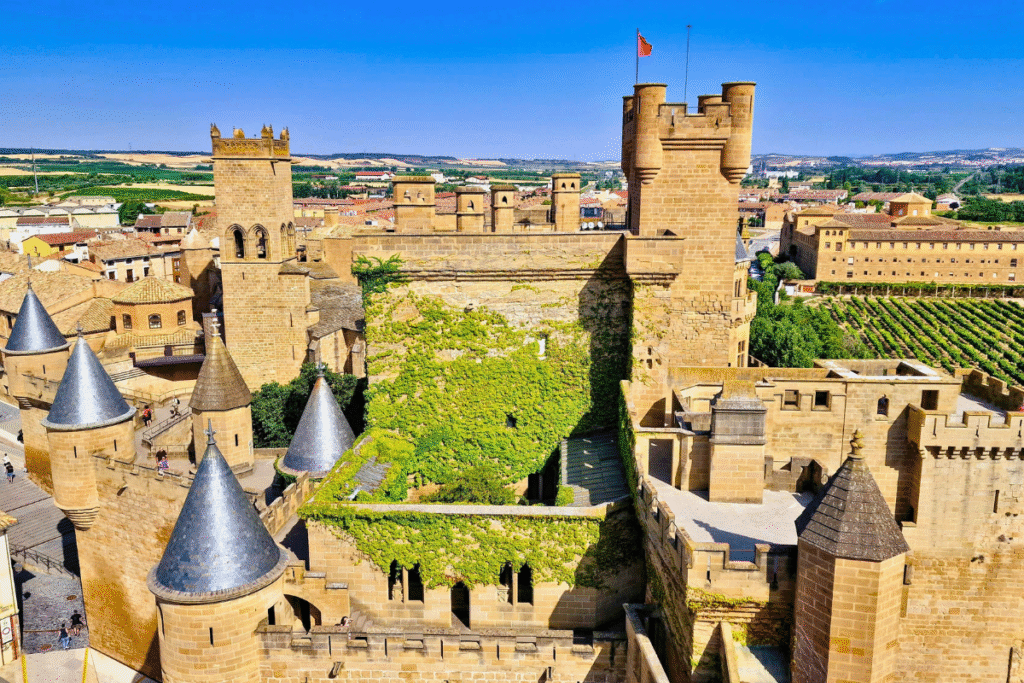
From afar, Olite doesn’t just look like a castle—it looks like a fantasy made real. Picture towers of every shape and height, each one capped with its own whimsical roof, all jumbled together like a medieval fever dream. But wander closer and you’ll discover a place that was once the most extravagant royal residence in Spain—built for luxury, legend, and show.
A Palace Fit for a King (and a Whole Court)
The kings of Navarre weren’t content with mere walls and moats. Charles III “the Noble” set out in the late 14th century to build a residence worthy of his title, and the result was pure grandeur. The palace became a maze of towers, hidden courtyards, hanging gardens, and sun-drenched terraces. Rumor has it that peacocks strutted through the gardens, and the royal stables once housed over a hundred horses.
Life at Olite was never dull. Tournaments, pageants, and balls filled the year. The palace overflowed with poets, knights, and courtiers, and even visiting dignitaries were stunned by the abundance—think grapevines climbing the walls, heated halls in winter, and every luxury medieval money could buy.
Legends, Lost Queens, and Royal Whispers
If walls could talk, Olite’s would have more stories than a whole library. Local legend tells of a secret passage leading from the palace to the nearby church, used by the queen for clandestine meetings. And then there’s the tale of a lost queen’s ghost, said to wander the gardens at night, searching for her vanished children.
The palace’s decline was as dramatic as its heyday—fires, wars, and centuries of abandonment left it in ruins until a painstaking restoration brought it back to life. Today, you can climb almost every tower, peek into grand halls, and even catch a medieval festival if you time it right.
Why This Castle Makes the Top 10
Olite isn’t just about stone and history—it’s about imagination. Every step takes you somewhere new: up a spiral stair to a lookout, through a hidden arch into a flower-filled courtyard, or out onto a terrace where you can almost hear music from a forgotten ball. It’s a place that feels built for exploring, for dreaming, and for letting your inner child run wild.
Families love it. So do couples, photographers, and anyone looking for a castle adventure with a twist of fairy tale. And because it’s not a massive tourist stop, you often get whole corners of the palace to yourself.
Spain Castle Travel Tips: Visiting Olite
- Getting There: Easy by car from Pamplona (40 minutes); buses connect from Pamplona and Tudela.
- Entry: General admission around €7.50; free for children under 6. Guided tours available for an extra fee—see official site for updated info.
- Tours: Self-guided or guided; pick the guided tour for quirky stories and hidden spots.
- Accessibility: Lower levels and main courtyards are accessible; towers require stairs.
- Best Time to Visit: Spring and late summer, especially during the annual Medieval Festival (usually in August).
- Must-Know: Give yourself time to get lost—the joy is in the wandering.
Nearby Attractions & Must-Dos
- Olite Old Town: Cobbled lanes, wine bars, and charming plazas just outside the palace gates.
- Navarre Wine Route: The region is famous for full-bodied reds—stop for a tasting.
- Ujué: A tiny hilltop village with an ancient church and breathtaking views.
Olite is proof that not all castles are about war and walls—some are about wonder. Come for the towers and stay for the stories, and you’ll understand why this is one of Spain’s most beautiful castles.

Castillo de Manzanares el Real
Quick Facts
| 🏗️ Construction Period | 1475–1490 |
| 🏰 Architectural Style | Late Gothic with Mudéjar touches |
| 🎭 Famous For | Immaculate preservation, battlements, lakeside setting |
| 👑 Notable Figures | Mendoza family, Cardinal Pedro González de Mendoza |
| 🏆 UNESCO Status | Not UNESCO, but declared a Spanish Cultural Heritage Site |
| 🌐 Official Website | Castillo de Manzanares el Real |
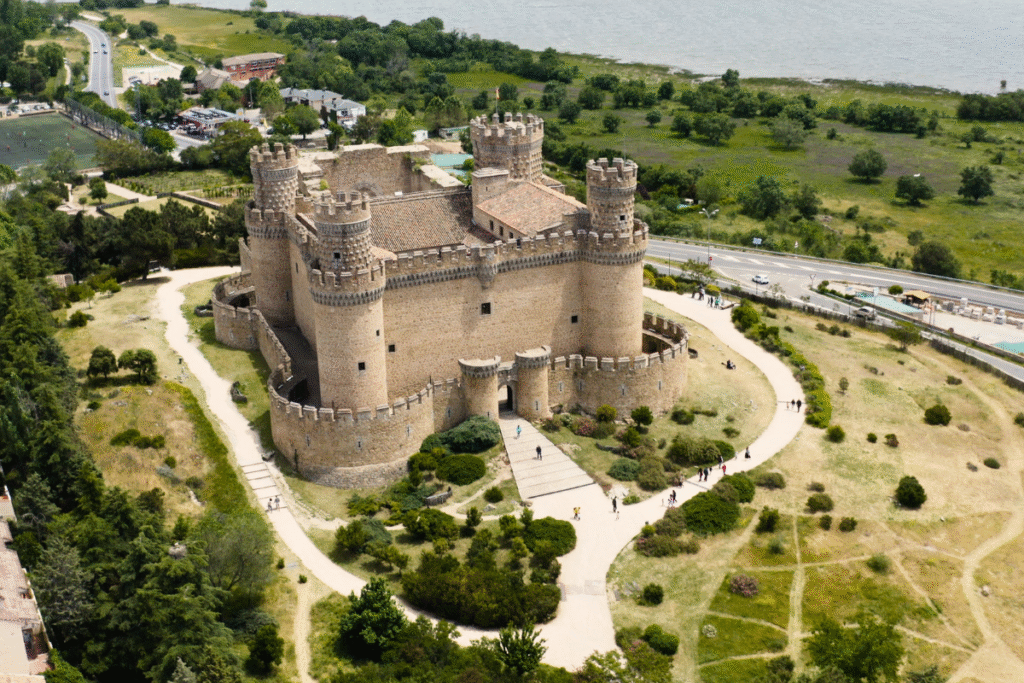
If you’re looking for a castle that delivers all the classic drama—turrets, crenellations, drawbridge, and even a mountain backdrop—Manzanares el Real is your answer. Just forty minutes from Madrid, it’s the kind of fortress you dream about as a kid, with thick walls, stone towers, and a perfect spot beside a shimmering reservoir.
From Noble Stronghold to Perfect Day Trip
Built at the end of the 15th century for the powerful Mendoza family, this castle was as much a status symbol as a military bastion. Its design is striking: four round towers anchor the corners, and delicate stonework decorates the balconies and parapets. Unlike many Spanish castles, Manzanares el Real has been carefully restored—step inside and you’ll find exhibits, period rooms, suits of armor, and even staged medieval banquets.
The Mendoza coat of arms is everywhere, a reminder of the family’s influence during the tumultuous days of Castile. Over time, the castle passed through different hands, survived wars, and hosted kings and queens. Thanks to restoration in the 20th century, today’s visitors get the rare treat of seeing a fortress almost exactly as it was meant to look.
Legends, Jousts, and Living History
Manzanares el Real isn’t just about quiet halls and pretty views. On weekends, the place comes alive with costumed guides, medieval reenactments, and archery workshops. There’s even the occasional jousting tournament in the wide courtyard—cheers from the crowd echoing off the ancient walls.
Local legend claims there’s treasure hidden in the foundations, placed there by the original builders to protect the Mendoza fortune. Kids will love hunting for the (very elusive) secret passageways.
Why This Castle Makes the Top 10
It’s rare to find a castle so close to a capital city that feels so complete—and so interactive. Manzanares el Real is perfect for families, first-time castle explorers, and anyone who wants to see Spanish history come to life without leaving Madrid’s orbit. The setting is gorgeous, too: on a clear day, you’ll spot the peaks of the Sierra de Guadarrama reflected in the lake.
If you’re after the “classic” Spanish castle experience—tower climbs, winding staircases, real armor—this is your place.
Spain Castle Travel Tips: Visiting Manzanares el Real
- Getting There: By car from Madrid (40 minutes) or direct bus (line 724) from Plaza de Castilla.
- Entry: General admission around €6; discounts for students, seniors, and families. See official site for current prices and opening hours.
- Tours: Audio guides available in English and Spanish; live reenactments most weekends.
- Accessibility: Lower levels and grounds are accessible; upper towers require stairs.
- Best Time to Visit: Spring and autumn for pleasant weather and fewer crowds. Arrive in the morning to see the lake at its most beautiful.
- Must-Know: Weekends can be busy due to events—book ahead if you can.
Nearby Attractions & Must-Dos
- La Pedriza: Stunning hiking and rock-climbing area right next door, part of the Sierra de Guadarrama National Park.
- Santillana Reservoir: Take a lakeside stroll or picnic with views of the castle.
- Traditional Mesones: Try the local cordero asado (roast lamb) in the town’s rustic taverns.
Manzanares el Real is where Spanish castle dreams come true. Bring the whole crew or come solo—just don’t be surprised if you find yourself planning a return visit before you’ve even left the gates.

Castillo de Cardona
Quick Facts
| 🏗️ Construction Period | 9th–15th centuries |
| 🏰 Architectural Style | Romanesque and Gothic, fortress-palace |
| 🎭 Famous For | Mighty hilltop position, Parador hotel, the “Minyona Tower” |
| 👑 Notable Figures | Wilfred the Hairy, Dukes of Cardona |
| 🏆 UNESCO Status | Not UNESCO, but protected as a Spanish Cultural Heritage Site |
| 🌐 Official Website | https://patrimoni.gencat.cat/en/monuments/monuments/cardona-castle |

If you want a castle with a view—and a story or two—Cardona is a must. Perched atop a rocky outcrop in central Catalonia, this sprawling stronghold commands the landscape for miles. It’s not just the scale that gets you: the sense of history is almost physical, clinging to every rampart and echoing through the old stone halls.
Fortress, Palace, and Legendary Prison
Built in the 9th century by Wilfred the Hairy (yes, that’s really his name), Cardona started as a frontier fortress against Moorish advances. Over centuries, it became a grand palace for the Dukes of Cardona, one of Catalonia’s most powerful families. The castle’s walls were never breached, even during the toughest sieges of the War of Spanish Succession—a point of local pride to this day.
The jewel of Cardona is the “Minyona Tower,” a soaring keep that has become the stuff of legend. According to local tales, a noble’s daughter was imprisoned here for falling in love with a Muslim prince. On misty mornings, they say you can still hear her sighs carried on the wind.
Romanesque Masterpieces and a Hotel Stay Like No Other
Inside the walls, you’ll find the 11th-century Church of Sant Vicenç—a Romanesque beauty with high vaulted ceilings and ancient frescoes. Much of the castle has been converted into a parador, one of Spain’s historic hotels. Sleep in a room with stone walls, wake up to sunrise over the Catalan plains, and wander corridors that have seen everything from medieval banquets to desperate last stands.
Want to really immerse yourself? Spend the night. There’s something unforgettable about exploring the ramparts at dusk, then relaxing in a castle lounge with a glass of local wine.
Why This Castle Makes the Top 10
Cardona is a living, breathing slice of Spanish history. It’s enormous, atmospheric, and packed with stories—from medieval princesses to victorious dukes and modern-day travelers seeking a night in a fortress. Whether you’re here for the legends, the architecture, or just the view, Cardona is impossible to forget.
Plus, its combination of fortress, church, and hotel makes it unique—there aren’t many places in Spain where you can sleep like a noble and wake up with a castle all to yourself.
Spain Castle Travel Tips: Visiting Cardona
- Getting There: 1.5-hour drive from Barcelona; buses run from Manresa, which is connected to Barcelona by train.
- Entry: Castle grounds free to explore; guided tour (castle + church) around €8–€10. Check the official website for the most up-to-date visiting information. Staying overnight? Book the Parador de Cardona.
- Tours: Guided tours in English, Catalan, and Spanish. Don’t miss the Minyona Tower and church crypt.
- Accessibility: Many steep slopes and stairs; limited access for those with mobility needs.
- Best Time to Visit: Autumn for clear skies and fewer crowds. Overnight stays are magical any time of year.
- Must-Know: Reserve ahead if you want to stay overnight—rooms fill fast, especially on weekends.
Nearby Attractions & Must-Dos
- Salt Mountain Cultural Park: Fascinating tours of Cardona’s historic salt mines—fun and educational.
- Old Town Cardona: Cobblestone streets, lively markets, and great bakeries for breakfast.
- Montserrat: A detour to this famous mountain monastery makes a perfect day trip.
Some castles are meant for quick visits. Cardona is one you’ll want to savor, whether for a day or—if you’re lucky—a night behind its mighty walls.

Castillo de la Mota
Quick Facts
| 🏗️ Construction Period | 15th century (with earlier 11th-century origins) |
| 🏰 Architectural Style | Gothic-Mudejar, red brick with defensive towers |
| 🎭 Famous For | Massive moat, towering keep, state prison for royalty |
| 👑 Notable Figures | Queen Isabella I, Cesare Borgia, Juana la Loca (Joanna the Mad) |
| 🏆 UNESCO Status | Not UNESCO, but recognized as a Spanish Cultural Heritage Site |
| 🌐 Official Website | www.castillodelamota.es |

Approach Medina del Campo and Castillo de la Mota leaps from the earth in a blaze of red brick and defensive muscle. This isn’t the kind of castle you stumble upon by accident—it dominates the town, its towers and thick walls rising above everything else. With its giant moat and signature “mota” (mound), it looks built to withstand anything—and for centuries, it pretty much did.
Fortress, Palace, and Prison: A Castle of Many Lives
Castillo de la Mota began as a fortress, but it soon became one of the crown’s most important strongholds in Castile. In the late 15th century, Queen Isabella I spent time here—she even received the news of her brother’s death and her own destiny to become queen within these walls. Later, the castle became infamous as a prison for high-profile captives, including Cesare Borgia and the tragic Juana la Loca, who was kept here for years.
Its Gothic-Mudejar style is unique: the castle’s signature red brick, massive towers, and deep moat make it as intimidating as it is beautiful. You can practically feel the tension between luxury and defense in every stone.
Legends, Escape Tunnels, and Haunted Halls
The castle brims with stories. Locals whisper of hidden tunnels running under the moat—one tale claims Cesare Borgia escaped by climbing down a rope from his cell, only to be captured in the woods outside. There are rumors of ghostly apparitions in the keep, especially on stormy nights, and guides love to recount dramatic plots and betrayals.
If you visit the main tower (the keep), don’t miss the views over the town and plains—they’re spectacular, especially at sunset.
Why This Castle Makes the Top 10
La Mota is a true fortress—massive, mighty, and wrapped in history both glorious and grim. It’s a perfect example of late medieval military architecture, and the stories of queens, prisoners, and intrigue make every corridor worth exploring. Unlike some castles, it’s lively with activities—reenactments, exhibitions, and summer concerts often bring the grounds to life.
History buffs will geek out over the details; families will love the ramparts and dungeons. If you want a castle that still feels like it could defend against a siege, this is it.
Spain Castle Travel Tips: Visiting la Mota
- Getting There: Easy drive from Valladolid (40 minutes); buses and trains connect Medina del Campo with major cities.
- Entry: Around €5–€9 for a guided tour (required for the tower); grounds and exhibitions often free. Check the official website for current details and special events.
- Tours: Guided visits are the only way to access the keep—worth it for the history and views.
- Accessibility: Most exterior areas are accessible; the keep and upper ramparts require stairs.
- Best Time to Visit: Spring and autumn for mild weather. Arrive early or during a festival for extra activities.
- Must-Know: Book tours ahead, especially in summer or during school holidays.
Nearby Attractions & Must-Dos
- Medina del Campo: Explore the lively town center and historic market square.
- Royal Testamentary Palace: Where Queen Isabella I wrote her will—an underrated gem.
- Rueda Wine Region: Just outside town, famous for crisp white wines and vineyard tours.
Castillo de la Mota is where Spanish history gets gritty and grand all at once. Whether you’re after dramatic stories, military might, or just a proper castle adventure, you’ll find it on top of this red-brick mound.

Which Castle Is Best for You? How to Plan Your Spain Castle Adventure
So—ten castles, ten wildly different personalities. If you’re staring at your Spain map wondering how to choose, you’re not alone. Here’s the good news: there’s a perfect castle (or three) for every kind of traveler.
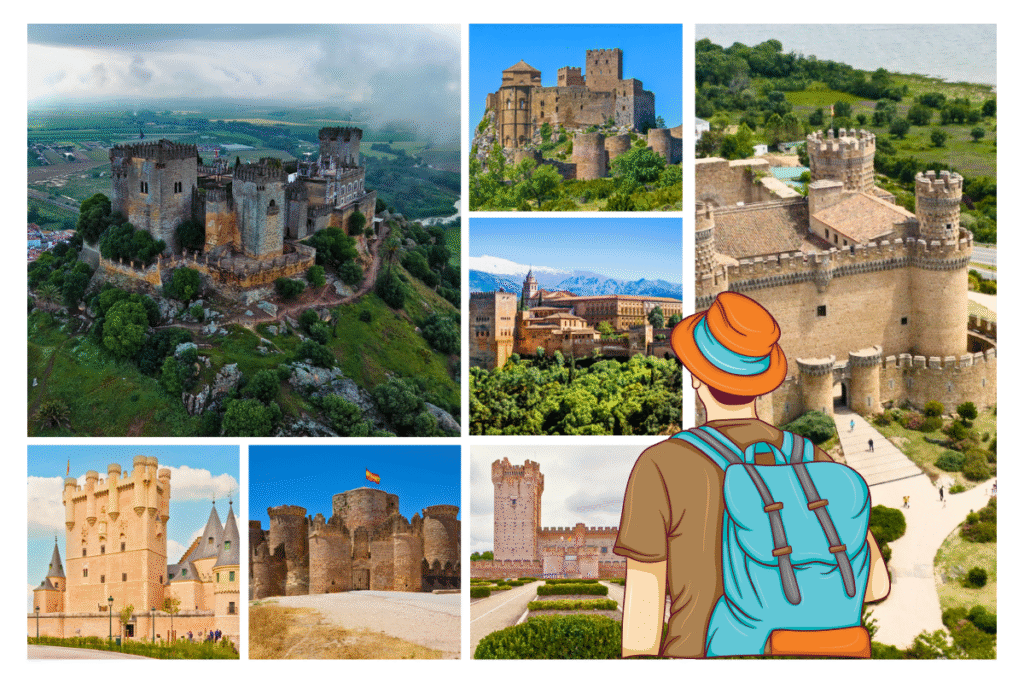
Best Castles for Families
- Manzanares el Real: Easy day trip from Madrid, interactive exhibits, and medieval reenactments that kids actually love.
- Castillo de Belmonte: Jousting tournaments and hands-on activities make it a hit for all ages.
- Olite: Feels like stepping into a storybook, with towers to climb and gardens to explore.
Best for Romantics and Dreamers
- Alhambra: Gardens and palaces made for wandering hand in hand, especially at sunset.
- Olite: Medieval palatial vibes, hidden courtyards, and quiet corners.
- Alcázar of Segovia: The view from the tower at sunrise—pure magic.
Best for History Buffs
- Castillo de la Mota: Fortresses, intrigue, and the drama of queens and prisoners.
- Cardona: Live out your medieval fantasies (and even sleep in the castle).
- Loarre: The oldest, purest fortress for those who love ancient stone and true stories.
Best for Photographers
- Peñafiel: Unique ship-like silhouette and incredible vineyard views.
- Almodóvar del Río: Dramatic hilltop setting and “Game of Thrones” bragging rights.
- Alhambra: Patterns, arches, and vistas—there’s nowhere quite like it.
Best Off-the-Beaten-Path Experience
- Loarre: Wild Pyrenean backdrops and few crowds.
- Cardona: Stay overnight for a private castle experience.
- Belmonte: Uncrowded and full of surprises, especially during festival days.
Sample Castle Itineraries
Central Spain Loop:
Start in Madrid (Manzanares el Real), head to Segovia for the Alcázar, then drive north to Peñafiel and end at Castillo de la Mota in Medina del Campo. That’s four castles, a few medieval towns, and some top-notch wine—all in a long weekend.
Andalusian Fantasy:
Base yourself in Córdoba. Visit Almodóvar del Río and then train to Granada for the Alhambra. Extra days? Explore Moorish palaces and gardens across the region.
Northern Gems Road Trip:
Rent a car from Zaragoza, visit Loarre and Olite, and cross into wine country for Peñafiel. Throw in Cardona for an overnight stay you’ll never forget.
History Lover’s Route:
Begin at Castillo de la Mota, wander to Cardona, and spend a day (or night) soaking up centuries in those fortress walls.
Tips for Planning:
- Book tickets early for Alhambra and festival days at Belmonte or Olite.
- Go off-peak for fewer crowds—late spring and autumn are gold.
- Mix city and countryside: Big-name castles near major cities pair well with quiet villages and rural fortresses.
- Don’t rush. Give yourself time to linger on a rampart or lose an hour in a hidden garden.
Have a week? Mix and match by region. Only have a day in Madrid? Manzanares el Real gives you the full castle fix without a long haul.
Bottom line? Spain’s castles are about more than stone and history—they’re about feeling small in the shadow of something big, and maybe a little timeless, too. Find your favorite, or make it a quest to visit them all.

Final Thoughts
Here’s the thing about castles in Spain: no matter how many you see, you’ll never quite get used to the feeling of standing inside a place that’s held so many lives, secrets, and surprises. I’ve lost count of the times I’ve been floored by a sudden view—a tower cutting into the sunset, an empty hall echoing with memories, or the hush that falls as you climb ancient stairs and realize how much these walls have seen.
What I love most is how each castle has its own pulse. Some are bright and lively, full of laughter and festivals. Others are quiet, a little wild, and perfect for those moments when you just want to listen to the wind. Whether you came for the history, the legends, the photos, or just the excuse to eat your weight in tapas after a day of exploring, I promise you’ll find something to remember.
So—what’s next? Are you planning to storm the ramparts at Segovia, wander the lion courts of the Alhambra, or lose yourself in the towers of Olite? Maybe you’ll try to visit them all (just be warned: castle fever is real, and it’s contagious).
Have you explored any of Spain’s castles? I’d love to hear your stories, your best travel tips, or even the moments that took your breath away. Share in the comments 💬 below, tag 👻 your adventures with @CastleQuestChronicles on Instagram, or join our community of castle lovers—because the best legends are the ones we make together.
👉 Love castles as much as we do? Don’t miss our guides to the best castles in Germany, Scotland, and France. And remember—sometimes, all it takes is a single tower or a half-forgotten legend to inspire your next big adventure.
Happy castle hunting, and see you on the ramparts!
📸 And if this article sparked your curiosity about the castles, follow along. We are on Instagram, Pinterest, Facebook, and X, too. More castles (and more stories) are just around the bend. Explore all our castle adventures here!

